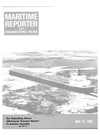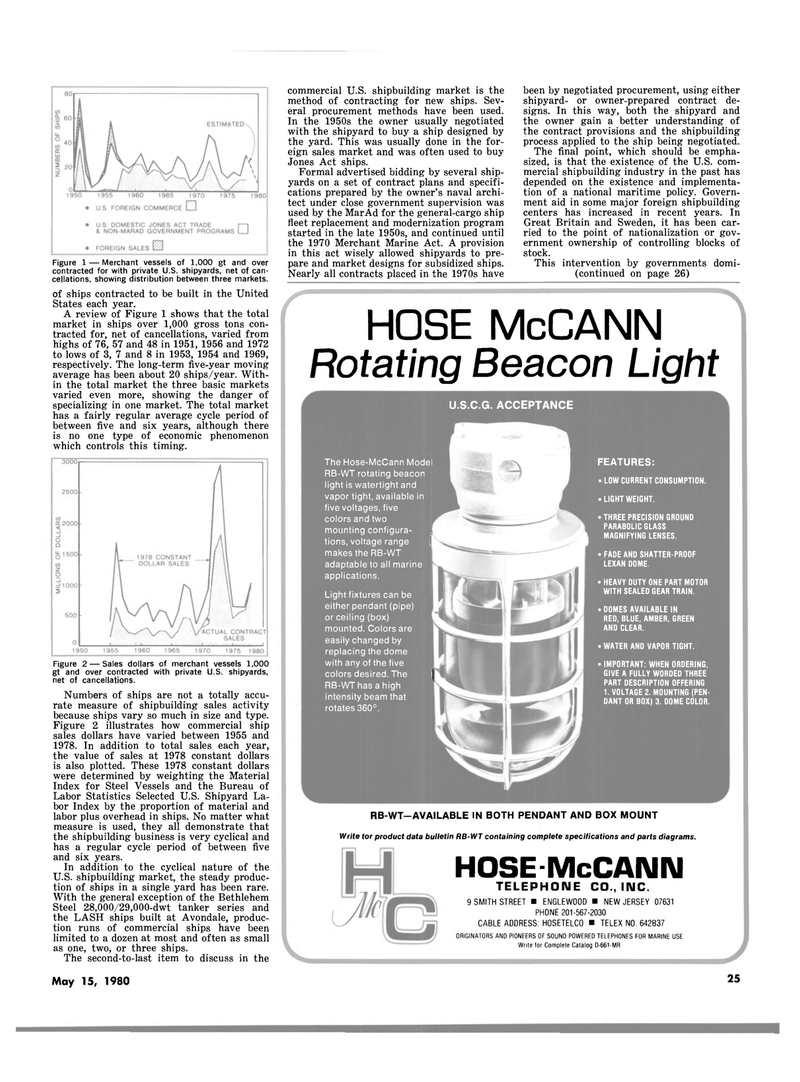
Page 23: of Maritime Reporter Magazine (May 15, 1980)
Read this page in Pdf, Flash or Html5 edition of May 15, 1980 Maritime Reporter Magazine
Figure 1 — Merchant vessels of 1,000 gt and over contracted for with private U.S. shipyards, net of can- cellations, showing distribution between three markets. of ships contracted to be built in the United
States each year.
A review of Figure 1 shows that the total market in ships over 1,000 gross tons con- tracted for, net of cancellations, varied from highs of 76, 57 and 48 in 1951, 1956 and 1972 to lows of 3, 7 and 8 in 1953, 1954 and 1969, respectively. The long-term five-year moving average has been about 20 ships/year. With- in the total market the three basic markets varied even more, showing the danger of specializing in one market. The total market has a fairly regular average cycle period of between five and six years, although there is no one type of economic phenomenon which controls this timing.
Figure 2 — Sales dollars of merchant vessels 1,000 gt and over contracted with private U.S. shipyards, net of cancellations.
Numbers of ships are not a totally accu- rate measure of shipbuilding sales activity because ships vary so much in size and type.
Figure 2 illustrates how commercial ship sales dollars have varied between 1955 and 1978. In addition to total sales each year, the value of sales at 1978 constant dollars is also plotted. These 1978 constant dollars were determined by weighting the Material
Index for Steel Vessels and the Bureau of
Labor Statistics Selected U.S. Shipyard La- bor Index by the proportion of material and labor plus overhead in ships. No matter what measure is used, they all demonstrate that the shipbuilding business is very cyclical and has a regular cycle period of between five and six years.
In addition to the cyclical nature of the
U.S. shipbuilding market, the steady produc- tion of ships in a single yard has been rare.
With the general exception of the Bethlehem
Steel 28,000/29,000-dwt tanker series and the LASH ships built at Avondale, produc- tion runs of commercial ships have been limited to a dozen at most and often as small as one, two, or three ships.
The second-to-last item to discuss in the commercial U.S. shipbuilding market is the method of contracting for new ships. Sev- eral procurement methods have been used.
In the 1950s the owner usually negotiated with the shipyard to buy a ship designed by the yard. This was usually done in the for- eign sales market and was often used to buy
Jones Act ships.
Formal advertised bidding by several ship- yards on a set of contract plans and specifi- cations prepared by the owner's naval archi- tect under close government supervision was used by the Mar Ad for the general-cargo ship fleet replacement and modernization program started in the late 1950s, and continued until the 1970 Merchant Marine Act. A provision in this act wisely allowed shipyards to pre- pare and market designs for subsidized ships.
Nearly all contracts placed in the 1970s have been by negotiated procurement, using either shipyard- or owner-prepared contract de- signs. In this way, both the shipyard and the owner gain a better understanding of the contract provisions and the shipbuilding process applied to the ship being negotiated.
The final point, which should be empha- sized, is that the existence of the U.S. com- mercial shipbuilding industry in the past has depended on the existence and implementa- tion of a national maritime policy. Govern- ment aid in some major foreign shipbuilding centers has increased in recent years. In
Great Britain and Sweden, it has been car- ried to the point of nationalization or gov- ernment ownership of controlling blocks of stock.
This intervention by governments domi- (continued on page 26)
HOSE McCANN Rotating Beacon Light
U.S.C.G. ACCEPTANCE
The Hose-McCann Model
RB-WT rotating beacon light is watertight and vapor tight, available in five voltages, five colors and two mounting configura- . tions, voltage range j makes the RB-WT adaptable to all marine applications.
Light fixtures can be either pendant (pipe) or ceiling (box) mounted. Colors are easily changed by replacing the dome with any of the five colors desired. The |
RB-WT has a high intensity beam that rotates 360°.
FEATURES: • LOW CURRENT CONSUMPTION. • LIGHTWEIGHT. • THREE PRECISION GROUND
PARABOLIC GLASS
MAGNIFYING LENSES. • FADE AND SHATTER-PROOF
LEXAN DOME. • HEAVY DUTY ONE PART MOTOR
WITH SEALED GEAR TRAIN. • DOMES AVAILABLE IN
RED, BLUE, AMBER, GREEN
AND CLEAR. • WATER AND VAPOR TIGHT. • IMPORTANT: WHEN ORDERING,
GIVE A FULLY WORDED THREE
PART DESCRIPTION OFFERING 1. VOLTAGE 2. MOUNTING (PEN-
DANT OR BOX) 3. DOME COLOR.
RB-WT—AVAILABLE IN BOTH PENDANT AND BOX MOUNT
Write tor product data bulletin RB-WT containing complete specifications and parts diagrams.
HOSE-McCANIM
TELEPHONE CO., INC. 9 SMITH STREET • ENGLEWOOD • NEW JERSEY 07631
PHONE 201-567-2030
CABLE ADDRESS: H0SETELC0 • TELEX NO. 642837
ORIGINATORS AND PIONEERS OF SOUND POWERED TELEPHONES FOR MARINE USE
Write tor Complete Catalog D-661-MR
May 15, 1980 25

 22
22

 24
24
